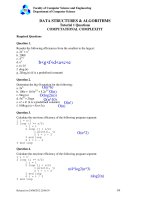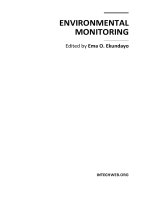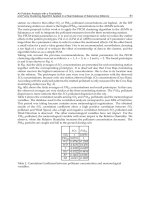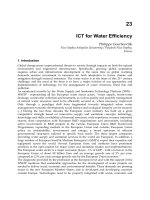International Environmental Law Part 1 potx
Bạn đang xem bản rút gọn của tài liệu. Xem và tải ngay bản đầy đủ của tài liệu tại đây (391.81 KB, 54 trang )
P1: JZP
0521868122pre Printer: Sheridan CUFX037/Louka 0 521 86812 2 August 16, 2006 10:10
ii
This page intentionally left blank
P1: JZP
0521868122pre Printer: Sheridan CUFX037/Louka 0 521 86812 2 August 16, 2006 10:10
International Environmental Law
This book analyzes the law and policy for the management of global common resources. As
competing demands on the global commons are increasing, the protection of the environ-
ment and the pursuit of growth give rise to all sorts of conflicts. The book analyzes issues in
the protection of the global commons from fairness, effectiveness, and world order perspec-
tives. The author examines whether current policy making and future trends point to a fair
allocation of global common resources that will be effective in protecting the environment
and in the pursuit of sustainable development. The author looks at the cost effectiveness of
international environmental law and applies theories of national environmental law to inter-
national environmental problems. Chapters include analysis of areas such as marine pollution,
air pollution, fisheries management, transboundary water resources, biodiversity, hazardous
and radioactive waste management, state responsibility, and liability.
Elli Louka is the founder of Alphabetics Development & Investment (ADI), a company
devoted to environment and development. Louka was a Senior Fellow at the Orville H. Schell
Center for International Human Rights at Yale Law School and a Ford Foundation Fellow at
New York University School of Law. Dr. Louka is currently the recipient of a Marie Curie
Fellowship provided by the European Commission of the European Union. Other selected
publications by Dr. Louka include Conflicting Integration: The Environmental Law of the European
Union (2004), Biodiversity and Human Rights (2002), and Overcoming National Barriers to Inter-
national Waste Trade (1994).
i
P1: JZP
0521868122pre Printer: Sheridan CUFX037/Louka 0 521 86812 2 August 16, 2006 10:10
ii
P1: JZP
0521868122pre Printer: Sheridan CUFX037/Louka 0 521 86812 2 August 16, 2006 10:10
International
Environmental
Law
Fairness, Effectiveness, and
World Order
Elli Louka
iii
cambridge university press
Cambridge, New York, Melbourne, Madrid, Cape Town, Singapore, São Paulo
Cambridge University Press
The Edinburgh Building, Cambridge cb2 2ru, UK
First published in print format
isbn-13 978-0-521-86812-9
isbn-13 978-0-521-68759-1
isbn-13 978-0-511-24967-9
© Elli Louka 2006
2006
Information on this title: www.cambridge.org/9780521868129
This publication is in copyright. Subject to statutory exception and to the provision of
relevant collective licensing agreements, no reproduction of any part may take place
without the written permission of Cambridge University Press.
isbn-10 0-511-24967-5
isbn-10 0-521-86812-2
isbn-10 0-521-68759-4
Cambridge University Press has no responsibility for the persistence or accuracy of urls
for external or third-party internet websites referred to in this publication, and does not
guarantee that any content on such websites is, or will remain, accurate or appropriate.
Published in the United States of America by Cambridge University Press, New York
www.cambridge.org
hardback
p
a
p
erback
p
a
p
erback
eBook (EBL)
eBook (EBL)
hardback
P1: JZP
0521868122pre Printer: Sheridan CUFX037/Louka 0 521 86812 2 August 16, 2006 10:10
Contents
Foreword by W. Michael Reisman
page xi
Abbreviations xiii
Introduction 1
Chapter 1. Introduction to International Environmental Law 5
1 The World Community and International Law 5
1.1 International Law 5
1.2 States 6
1.2.1 Sovereignty
1.2.2 Wealth
1.2.3 Cooperation
1.3 International Organizations 11
1.4 Nongovernmental Actors 16
2 International Lawmaking Process 20
2.1 Treaties 21
2.2 Custom 23
2.3 Principles of Law 24
2.4 Other Sources 25
2.5 Content 25
3Perspectives 27
3.1 Developed Countries 27
3.2 Developing Countries 28
4 Historical Evolution 30
4.1 Stockholm 30
4.2 Rio 32
4.3 Johannesburg 35
4.4 From Stockholm to Johannesburg 38
4.5 Case Law 39
5 Globalization and International Law 47
v
P1: JZP
0521868122pre Printer: Sheridan CUFX037/Louka 0 521 86812 2 August 16, 2006 10:10
vi Contents
6Principles 49
6.1 Sovereignty over Natural Resources 49
6.2 Obligation Not to Cause Damage 50
6.3 Principles of Preventive Action and Precaution 50
6.4 Polluter Pays Principle and Equitable Sharing of Cost 51
6.5 Sustainable Development 52
6.6 Equitable Utilization 53
6.7 Common but Differentiated Responsibilities 54
6.8 Human Rights 54
7 Settlement of Disputes 55
8 Monitoring and Enforcement 57
Chapter 2. Foundations of International Environmental Law 59
1 Functions of Law 59
2Foundations 65
2.1 Minimum Order 66
2.2 Equity 67
2.3 Effectiveness as Equity 70
2.4 Cost-Effectiveness 73
3Regulation of Natural Resources 75
4 Enclosure of National Commons 78
5 Enclosure of Global Commons 80
5.1 Fisheries 81
5.2 Deep Sea-Bed Resources 83
5.3 Germplasm and Related Knowledge 86
5.4 Freshwater Resources 88
5.5 Air 89
5.6 Seas 91
5.7 Waste Management 92
5.8 National Biodiversity Resources 93
6 Enclosure of Global Commons and Global Welfare 95
7 International Instruments 108
8 Conclusion 111
Chapter 3. Compliance and Governance Mechanisms 114
1Environmental and Strategic Impact Assessment 114
2 State Obligations 120
2.1 Exchange of Information 121
2.2 Notification 122
2.3 Consultation 123
2.4 Reporting/Monitoring 124
P1: JZP
0521868122pre Printer: Sheridan CUFX037/Louka 0 521 86812 2 August 16, 2006 10:10
Contents vii
3Verification and Compliance 126
4 Right to Information and Participation and Access to Justice 129
4.1 International Instruments 129
4.2 Application of Right to Information 136
5 Conclusion 140
Chapter 4. Marine Environment 141
1 State of Marine Environment 141
2 Integrated Coastal Zone Management 144
3Evolution of International Instruments 146
3.1 Law of the Sea Convention 146
3.2 Pollution from Dumping 148
3.3 Regional Management 153
3.4 Pollution from Ships 154
3.5 Emergency Situations 159
3.6 Safety Regulations 159
4 Selected Regional Instruments 161
4.1 Protection of the Northeast Atlantic 161
4.2 Protection of the Baltic Sea 162
4.3 UNEP Regional Seas Program 163
5 Conclusion 167
Chapter 5. Water Resources 169
1 State of Water Resources 169
2 Issues in Water Management 172
2.1 Allocation and Equity 172
2.1.1 Substantive Equity
2.1.2 Procedural Equity and Institutional Development
2.1.3 Principled Equitable Utilization or Ad Hoc Regionalism?
2.2 Efficiency and Quality 179
2.3 Integrated Water Resources Management 182
2.3.1 National
2.3.2 International
3 Case Law 185
4 International Instruments 188
5Regional Instruments 192
5.1 Africa 193
5.2 Asia 209
5.3 Middle East 218
5.4 Europe 223
5.4.1 Suprabasin Instruments
5.4.2 Basin-Specific Instruments
P1: JZP
0521868122pre Printer: Sheridan CUFX037/Louka 0 521 86812 2 August 16, 2006 10:10
viii Contents
5.5 American Region 239
5.5.1 United States–Canada
5.5.2 United States–Mexico
6 Conclusion 243
Chapter 6. Fisheries Resources 244
1 State of World Fisheries 244
2 National Management of Fisheries Resources 245
2.1 Regulation 245
2.2 Privatization 247
3 International Management of Fisheries Resources 250
3.1 Law of the Sea Convention 250
3.2 Case Law 251
3.3 International Instruments 258
3.3.1 Agreement on Fisheries Management
3.3.2 FAO Code of Conduct for Responsible Fisheries
3.4 Regional Agreements 264
3.5 Case Studies 268
3.5.1 South East Atlantic Fisheries Organization (SEAFO)
3.5.2 South Pacific Forum Fisheries Agency (SPFFA) and Western
and Central Pacific Commission (WCPC)
3.5.3 North East Atlantic Fisheries Commission (NEAFC)
3.5.4 Northwest Atlantic Fisheries Organization (NAFO)
3.5.5 International Commission for the Conservation of Atlantic Tuna
(ICCAT)
3.5.6 General Fisheries Commission of the Mediterranean (GFCM)
3.5.7 Commission for the Conservation of Antarctic Marine Living
Resources (CCAMLR)
4 Conclusion 286
Chapter 7. Biodiversity 288
1 Biodiversity Management 288
1.1 State of Biodiversity Resources 288
1.2 National and Transnational Protected Areas 289
1.3 Gene Banks 296
2 International Instruments 299
2.1 Biodiversity Convention 299
2.1.1 Biodiversity Protection
2.1.2 Resource Allocation
2.1.2.1 Market Value of Biodiversity
2.1.2.2 Bilateral Redistribution
2.1.2.3 Transnational Redistribution
2.1.2.4 Institutionalized Redistribution
2.2 Trade and Biodiversity 314
3Protection of Habitats 316
3.1 World Heritage Sites 316
P1: JZP
0521868122pre Printer: Sheridan CUFX037/Louka 0 521 86812 2 August 16, 2006 10:10
Contents ix
3.2 Forests 318
3.3 Wetlands 322
4Regional Instruments 323
4.1 Europe 323
4.2 Africa 326
4.3 South East Asia 330
4.4 Antarctica 332
4.5 Other Regional Instruments 333
5Protection of Species 335
5.1 Protection of Migratory Species 335
5.2 Protection of Whales 337
5.3 Protection of Seals 339
5.4 Other Agreements 340
6 Conclusion 342
Chapter 8. Air Pollution 343
1 Ozone Depletion 344
1.1 Negotiating Process 344
1.2 Legislative Instruments 346
1.2.1 Protection of Ozone Layer
1.2.2 Regulation of Ozone-Depleting Substances
1.3 Conclusion 355
2 Climate Change 356
2.1 Negotiating Process 357
2.2 Legislative Instruments 361
2.2.1 Convention on Climate Change
2.2.2 Regulation of Greenhouse Gases
2.2.3 Market-Based Regulation of Greenhouse Gases
2.3 Conclusion 373
3Transfrontier Air Pollution 374
3.1 Legislative Instruments 376
3.1.1 Convention on Transboundary Air Pollution
3.1.2 Regulation of Air Pollutants
3.2 Conclusion 382
Chapter 9. Trade and Environment 383
1World Trade Institutions 383
2 The Treaties 384
3 Dispute Settlement 385
3.1 General Agreement on Tariffs and Trade 386
3.2 Sanitary and Phytosanitary Measures 394
4 Intellectual Property Rights and Trade 399
4.1 Intellectual Property Rights Institutions and Trade 401
P1: JZP
0521868122pre Printer: Sheridan CUFX037/Louka 0 521 86812 2 August 16, 2006 10:10
x Contents
4.2 Intellectual Property Rights and Pharmaceuticals 409
4.3 Intellectual Property Rights and Genetic Resources 412
4.3.1 Letter of TRIPs
4.3.2 State Practice
4.3.3 Seed Wars
4.3.4 TRIPs and Traditional Knowledge
4.3.5 TRIPs and Farmers’ Rights
5 Conclusion 420
Chapter 10. Hazardous and Radioactive Wastes 424
1 State of International Waste Trade 424
2 State of Waste Management 425
2.1 Landfill/Geologic Disposal 425
2.2 Marine Disposal 426
2.3 Treatment 426
2.4 Incineration 426
2.5 Recycling and Reprocessing 427
3 International Instruments 428
3.1 Hazardous Wastes 428
3.2 Radioactive Wastes 434
4 National Regulatory Dilemmas 437
4.1 The United States 437
4.1.1 Management of Hazardous Wastes
4.1.2 Management of Radioactive Wastes
4.1.3 Management of Waste Trade
4.2 European Union 441
4.2.1 Management of Hazardous Wastes
4.2.2 Management of Radioactive Wastes
4.2.3 Management of Waste Trade
5 Conclusion 446
Chapter 11. Liability and State Responsibility 448
1 Oil Pollution 451
2 Hazardous Materials Trade 456
2.1 CRTD Convention 456
2.2 HNS Convention 459
2.3 Liability for Waste Trade 461
3 Nuclear Energy 462
4 Liability for Damage to the Environment 466
5 State Responsibility 468
6 International Liability 475
7 Conclusion 481
International Treaties and Other Instruments 482
List of Cases 491
Index 495
P1: JZP
0521868122pre Printer: Sheridan CUFX037/Louka 0 521 86812 2 August 16, 2006 10:10
Foreword
Law, as Dr. Elli Louka vividly demonstrates in this extraordinary book, is most use-
fully conceived as a process of clarifying and implementing the common interests
of politically relevant actors. This conception is indispensable for understanding the
development of international environmental law. The spread of industrialization,
with its ever more intensive uses of the resources of the planet, followed by the
evolution of a global civilization of science and technology and, in part as a conse-
quence of those developments, the explosion of the population of the planet from
1.6 billion people in 1900 to 2.5 billion in 1950 and to more than 6 billion in
2000, have combined to put unprecedented and unrelenting stress on the ecological
systems on which the life of our species depends. No other area of lawmaking and
law-applying makes so clearly and vividly manifest the indispensable functions of all
law: the maintenance of minimum order, the allocation and regulation of the use of
scarce resources, and the conservation and allocation of the benefits and burdens of
the world’s resources in ways consistent with shared conceptions of equity.
Approaching this subject as if it could be studied as a body of static rules would be
sterile. Instead, Dr. Louka presents a dynamic picture, in which the diverse actors in
the international lawmaking process clarify key principles such as sovereignty over
national resources, precautionary principles with respect to equitable cost-sharing
of environmental externalities, principles of sustainable development, and common
as well as differentiated responsibilities. Dr. Louka then shows how those principles
are being applied in each of the major areas of international environmental law. Nor
can general international law be excluded from such an examination, for the legal
focus on the environment also has driven major changes in general international law,
which has acknowledged the “tragedy of commons” and in response has authorized
an increasing enclosure and nationalization of resources that for centuries had been
part of the res communis omnium.
Using as a framework this dynamic process in which international environmental
law is clarified, prescribed, and implemented, Dr. Louka reviews and synthesizes
past trends and projections of probable future trends with respect to (1) the marine
environment; (2) shared water resources; (3) fisheries resources; (4) the conservation
of biodiversity; (5) air; (6) trade and environment; and (7) the disposal of hazardous
and radioactive waste. Cutting across all of these trends and projection studies are
the international efforts to establish and police reporting and information-sharing
xi
P1: JZP
0521868122pre Printer: Sheridan CUFX037/Louka 0 521 86812 2 August 16, 2006 10:10
xii Foreword
regimes, many now driven by the daunting challenge of prescribing for some measure
of liability in circumstances in which acts with the potential for causing significant
transnational damage are not prohibited by international law. One of the many
strengths of Dr. Louka’s book is that it presents in extraordinarily rich detail the
entire spectrum of the modern process of international environmental law.
Much of the writing in contemporary international environmental law is pas-
sionately and uncritically advocative. Although Dr. Louka’s book is plainly animated
by a deep concern for the preservation of the environment of the planet and the
realization that in the context of a global civilization of science and technology, it
can be protected only by effective international efforts, the stance adopted is not
uncritical and Dr. Louka never surrenders the scholarly role. Precisely because some
of the areas that Louka treats are – good intentions notwithstanding – marked by mis-
steps or – serious efforts notwithstanding – have registered no significant successes,
Dr. Louka’s book will be important for the practitioner in the vineyard of interna-
tional environmental law no less than for the political leaders who are charged with
its development.
Dr. Louka has produced a remarkable book that will be of great value to the
profession.
W. Michael Reisman
Yale Law School
New Haven, Connecticut
December 2005
P1: JZP
0521868122pre Printer: Sheridan CUFX037/Louka 0 521 86812 2 August 16, 2006 10:10
Abbreviations
AAUs/assigned amount units (of
emissions)
ACCOBAMS/Agreement on the
Conservation of Cetaceans of the
Mediterranean and the Black Seas
ACP/African, Caribbean and Pacific
(countries)
ACTO/Amazon Cooperation Treaty
Organization
AIA/Advanced Informed Agreement
(procedure)
APFIC/Asia Pacific Fishery
Commission
ASCIs/Areas of Special Conservation
Interest
ASCOBANS/Agreement on the
Conservation of Small Cetaceans of
the Baltic and North Seas
ASEAN/Association of South East
Asian Nations
ATS/Antarctic Treaty System
BAT/best available technique
BATNEEC/best available technology
not entailing excessive costs
BEP/best environmental practice
CAMPs/Coastal Areas Management
Programmes
CBD/Convention on Biological
Diversity
CBNRM/community-based natural
resource management
CCAMLR/Convention for the
Conservation of Antarctic Marine
Living Resources
CCAS/Convention on the
Conservation of Antarctic Seals
CCRF/Code of Conduct for
Responsible Fisheries
CDM/Clean Development Mechanism
CDS/Catch Documentation Scheme
CECAF/Committee of the Eastern
Central Atlantic Fisheries
CERCLA/Comprehensive
Environmental Response,
Compensation and Liability
Act
CERs/certified emissions reductions
CFCs/chlorofluorocarbons
CGIAR/Consultative Group on
International Agricultural Research
CIAT/International Center for Tropical
Agriculture
CIFOR/Center for International
Forestry Research
CIMMYT/Center for the
Improvement of Maize and Wheat
CIP/International Potato Center
CITES/Convention on International
Trade in Endangered Species of Wild
Flora and Fauna
CLRTAP/Convention on Long-Range
Transboundary Air Pollution
COP/Conference of the Parties
xiii
P1: JZP
0521868122pre Printer: Sheridan CUFX037/Louka 0 521 86812 2 August 16, 2006 10:10
xiv Abbreviations
CRTD/Convention on Civil Liability
for Damage Caused During Carriage
of Dangerous Goods by Road, Rail
and Inland Navigation Vessels
CSC/Convention on Supplementary
Compensation for Nuclear Damage
CSD/Commission on Sustainable
Development
CTE/Committee on Trade and
Environment
DSB/Dispute Settlement Body
DWFS/distant water fishing states
EBRD/European Bank for
Reconstruction and Development
EC/European Community
ECE/Economic Commission for
Europe
ECJ/European Court of Justice
ECOSOC/Economic and Social
Council of the United Nations
EEA/European Environment Agency
EEC/European Economic Community
EEZ/Exclusive Economic Zone
EIA/Environmental Impact Assessment
EMEP/Cooperative Programme for
Monitoring and Evaluation of the
Long-Range Transmission of Air
Pollutants in Europe
EPA/Environmental Protection
Agency
ERUs/Emission Reduction Units
ESCWA/Economic and Social
Commission for Western Asia
ETS/European Treaties Series
EU/European Union
EUROBATS/Agreement on the
Conservation of Bats in Europe
FAO/Food and Agriculture
Organization
FFA/Forum Fisheries Agency
FFVs/foreign fishing vessels
FOC/flag of convenience
GAO/General Accounting Office
GATS/General Agreement on Trade in
Services
GATT/General Agreement on Tariffs
and Trade
GEF/Global Environment Facility
GESAMP/Joint Group of Experts on
the Scientific Aspects of Marine
Environmental Protection
GFCM/General Fisheries Council of
the Mediterranean
GPA/Global Programme of Action
HELCOM/Helsinki Convention for
the Protection of the Baltic Sea
IAEA/International Atomic Energy
Agency
IARCs/International Agricultural
Research Centers
IATP/Institute for Agriculture and
Trade Policy
IATTC/Inter-American Tropical Tuna
Commission
IBPGR/International Board for Plant
Genetic Resources
IBRD/International Bank for
Reconstruction and Development
ICARDA/International Center for
Agricultural Research in Dry
Areas
ICARM/Integrated Coastal and River
Basin Management
ICCAT/International Convention for
the Conservation of Atlantic Tunas
ICDM/Integrated Conservation and
Development Management
ICJ/International Court of Justice
ICNAF/International Convention for
the Northwest Atlantic Fisheries
ICPDR/International Commission for
the Protection of the Danube River
ICPR/International Commission for
the Protection of the Rhine
ICRAF/International Center for
Research in Agroforestry
ICRISAT/International Crops
Research Institute for the Semi-Arid
Tropics
ICZM/Integrated Coastal Zone
Management
P1: JZP
0521868122pre Printer: Sheridan CUFX037/Louka 0 521 86812 2 August 16, 2006 10:10
Abbreviations
xv
IDPs/internally displaced persons
IFPRI/International Food Policy
Research Institute
IITA/International Institute for Tropical
Agriculture
ILC/International Law Commission
ILO/International Labor Organization
ILRI/International Livestock Research
Institute
IMDG/International Maritime
Dangerous Goods (Code)
IMF/International Monetary Fund
IMO/International Maritime
Organization
INBO/International Network of Basin
Organizations
IOFC/Indian Ocean Fishery
Commission
IOTC/Indian Ocean Tuna Commission
IPCC/Intergovernmental Panel on
Climate Change
IPF/Intergovernmental Panel on Forests
IPGRI/International Plant Genetic
Resources Institute
IRBM/Integrated River Basin
Management
IRBO/International River Basin
Organizations
IRRI/International Rice Research
Institute
ISA/International Seabed Authority
ISNAR/International Service for
National Agricultural Research
ITLOS/International Tribunal for the
Law of the Sea
ITP/individual tradable permit
ITQs/individual transferable quotas
ITTA/International Tropical Timber
Agreement
ITTO/International Tropical Timber
Organization
IUCN/International Union for the
Conservation of Nature
IUU/illegal, unreported, and
unregulated fishing
IWC/International Whaling
Commission
IWIC/International Waste
Identification Code
IWRM/Integrated Water Resources
Management
LDC/London Dumping Convention
LLRWA/Low-Level Radioactive Waste
Act
LULUCF/land-use, land-use change,
and forest
MAP/Mediterranean Action Plan
MDBC/Murray-Darling Basin
Commission
MPAs/Marine Protected Areas
MTAs/Material Transfer Agreements
NAFC/Northwest Atlantic Fisheries
Convention
NAFO/Northwest Atlantic Fisheries
Organization
NAFTA/North American Free Trade
Agreement
NAMMCO/North Atlantic Marine
Mammals Commission
NASCO/North Atlantic Salmon
Conservation Organization
NATO/North Atlantic Treaty
Organization
NEA/OECD/Nuclear Energy Agency
of the Organization for Economic
Co-operation and Development
NEAFC/North East Atlantic Fisheries
Commission
NEPA/National Environmental Policy
Act
NGOs/nongovernmental
organizations
NIMBY/not in my backyard
NPAFC/North Pacific Anadromous
Stocks Commission
NPFSC/North Pacific Fur Seals
Commission
NWPA/Nuclear Waste Policy Act
OAS/Organization of American States
OAU/Organization of African Unity
ODA/Official Development Assistance
ODS/Ozone Depleting Substances
P1: JZP
0521868122pre Printer: Sheridan CUFX037/Louka 0 521 86812 2 August 16, 2006 10:10
xvi Abbreviations
OECD/Organization for Economic
Co-operation and Development
OPRC/Oil Pollution Preparedness,
Response, and Co-operation
OSPAR/Convention for the Protection
of the Marine Environment of the
North East Atlantic
PCA/Permanent Court of Arbitration
PCIJ/Permanent Court of International
Justice
PGR/Plant Genetic Resources
PIC/prior informed consent
POPs/persistent organic pollutants
PRTRs/pollutant release and transfer
registers
RAC/Regional Activity Centre
RBAs/River Basin Authorities
RBMP/River Basin Management Plan
RBOs/River Basin Organizations
RCRA/Resource Conservation and
Recovery Act
RFOs/Regional Fisheries
Organizations
SAARC/South Asian Association for
Regional Cooperation
SADC/Southern African Development
Community
SARA/Superfund Amendment and
Reauthorization Act
SBSTA/Subsidiary Body for Scientific
and Technological Advice
SEAFO/South East Atlantic Fisheries
Organization
SEA/Strategic Environmental
Assessment
SOLAS/International Convention for
the Safety of Life at Sea
SPFFA/South Pacific Forum Fisheries
Agency
SPREP/South Pacific Regional
Environment Program
SPS/Sanitary and Phytosanitary
Measures
TACs/total allowable catches
TBNRM/transboundary natural
resource management
TDPs/tradable discharge permits
TRIPs/Trade-Related Intellectual
Property Rights
TURFs/Territorial Use Rights in
Fishing
TVA/Tennessee Valley Authority
UNCED/United Nations Conference
on the Environment and
Development
UNCLOS/United Nations Convention
on the Law of the Sea
UNCTAD/United Nations Conference
on Trade and Development
UNDP/United Nations Development
Program
UN/ECE/United Nations Economic
Commission for Europe
UNESCAP/United Nations Economic
and Social Commission for Asia and
the Pacific
UNESCO/United Nations
Educational, Scientific, and Cultural
Organization
UNFF/United Nations Forum on
Forests
UPOV/Union for the Protection of
New Varieties of Plants
VMS/Vessel Monitoring System
VOCs/volatile organic compounds
WCPFC/Western and Central Pacific
Fisheries Convention
WECAFC/Western Central Atlantic
Fishery Commission
WFD/Water Framework Directive
WHO/World Health Organization
WIPO/World Intellectual Property
Rights Organization
WSSD/World Summit on Sustainable
Development
WTO/World Trade Organization
P1: JZP
0521868122int Printer: Sheridan CUFX037/Louka 0 521 86812 2 August 14, 2006 15:19
Introduction
This study examines the rules of international law governing the global commons.
Because global common resources are shared among states, competition for the use of
such resources and the sharing of externalities from resource use are bound to increase
in the future. The book examines how the quest for a minimum order, fairness, and
effectiveness has guided the development of international environmental law and
policy making.
Chapter 1 provides an introduction to international law and international envi-
ronmental law. It provides an overview of the actors of international lawmaking, the
international lawmaking process, and the historical evolution of international envi-
ronmental law. Concepts of international environmental law, such as sovereignty
over national resources, the “polluter pays” principle, the precautionary princi-
ple, equitable cost-sharing of environmental externalities, sustainable development,
and common but differentiated responsibilities are explored. The chapter examines
human rights as the threshold principles of international environmental lawmaking.
Issues of monitoring and enforcement in international law are also introduced.
Chapter 2 examines the foundations of international environmental law. The pur-
suit of minimum order, equity, and effectiveness in international law is analyzed and
the interconnection among the foundations of international environmental law is
explored. The chapter examines how issues of distributive equity often determine the
effectiveness of international environmental lawmaking. Issues of cost-effectiveness
as they influence the success of international environmental regimes are also exam-
ined. The enclosure of national common pool resources is introduced and analyzed.
More specifically, it is examined how many national/local common pool resource
systems could acquire differing forms of governance ranging from common property
and state property to private property. The “Tragedy of Commons” rationale that
precipitated the enclosure of common pool resources in national systems is driving
the enclosure of global common resources. The gradual enclosure of global com-
mon resources – as it is taking place in fisheries, germplasm resources and related
knowledge, freshwater resources, air, sea, waste management, and national biodi-
versity resources – is analyzed. Chapter 2 examines the interrelationship between
the nature of different enclosures and the effectiveness of international environmen-
tal regimes. The inclusionary or exclusionary nature of enclosures as they affect
perceptions of distributive equity is analyzed.
1
P1: JZP
0521868122int Printer: Sheridan CUFX037/Louka 0 521 86812 2 August 14, 2006 15:19
2 Introduction
Chapter 3 examines the compliance and governance mechanisms of international
environmental lawmaking such as environmental impact assessment, strategic envi-
ronmental assessment, exchange of information, notification, consultation, the right
to participation, and the right to information. The chapter examines whether such
instruments have been effective in the pursuit of international environmental law
objectives. The application of these instruments by international institutions and
states is particularly emphasized. Reporting, monitoring, and compliance proce-
dures as they are developing in different international environmental law regimes are
scrutinized.
The seas are a common pool resource that has become an open-access resource
in terms of pollution that states are putting into the seas. Chapter 4 examines the
different regulatory efforts that states have engaged in so as to diminish the open-
access character of the resource including the Law of the Sea Convention, the
MARPOL Convention, various regional conventions, and safety regulations. The
chapter concludes that – despite the efforts of states to enclose the global resources of
the seas under national or international regulatory regimes – the seas have remained
more or less an open-access resource in terms of pollution inputs.
Chapter 5 examines the problems associated with the management of shared water
resources. Water resources are not global resources like the seas but often are shared
among a number of states. As such, they are common pool resources that present the
collective action problems encountered in other common pool resource systems. The
chapter examines in detail the UN Watercourses Convention and its influence on the
articulation of regional instruments on the allocation and protection of freshwater
resources. Issues of equity in water allocation, efficiency, demand-led management,
and water quality are examined as they have been elaborated in different regional
fora, namely – Africa, Asia, Europe, the Middle East, and the American region.
Integrated water management, as it incorporates issues of water quantity and quality
at the river basin level, the establishment of Regional Basin Organizations (RBOs),
and their role in equitable and sound water management are explored in depth.
Fisheries are a typical example of global common resources. Fisheries are by
nature mobile resources, as they straddle sea areas under national jurisdiction and
the high seas. The management of fisheries has been a highly contentious issue in
international fora. Chapter 6 provides an overview of national regulatory systems for
fisheries resources ranging from the typical command-and-control measures to pri-
vatization through Individual Transferable Quotas (ITQs). The enclosure of national
fisheries resources has reverberated in international fora where states have been eager
to enclose global fisheries resources. The enclosure movement with regard to fish-
eries resources has been mostly exclusionary because the establishment of Regional
Fisheries Organizations, which increasingly assume rights beyond the Exclusive Eco-
nomic Zone (EEZ) of states, is rarely accommodating to new entrants. There are
even disputes among the states that are regime-insiders as they vie for the apportion-
ment of fisheries resources. Chapter 6 examines the international instruments for the
regulation of fisheries resources, including the 1995 Fisheries Agreement. Regional
efforts for the enclosure of fisheries resources are examined for the purposes of
revealing the degree of effectiveness of regional enclosure movements.
Most biodiversity resources, especially terrestrial biodiversity resources, are under
a state’s jurisdiction or are shared among a number of states in a region. Therefore,
P1: JZP
0521868122int Printer: Sheridan CUFX037/Louka 0 521 86812 2 August 14, 2006 15:19
Introduction 3
many biodiversity resources could not be characterized as the classic example of
global common resources. The biodiversity loss that is witnessed today world-
wide, however, has put biodiversity on the international agenda with a new sense
of urgency. The international management of biodiversity is characterized by two
trends. One trend has to do with the assertion of state sovereignty over germplasm
resources situated in nature or in gene banks. The other trend has to do with the
attempts of the international community to regulate national and local biodiversity
protection systems so as to implement an international enclosure of national com-
mons. As many states do not have adequate resources to protect and manage their
biodiversity resources, such resources often become open-access resources and are
degraded. National and transnational protected areas and regional and international
gene banks are methods that have been used for the protection of biodiversity. The
international system has attempted to regulate the national management of biodiver-
sity through trade mechanisms, which prohibit or restrict the trade in endangered
species, and through a number of conventions that address regional biodiversity issues
or species-specific conservation issues. The effectiveness and equity of national and
international mechanisms for the protection of biodiversity resources are examined
in Chapter 7.
The Convention on Biological Diversity was the first convention to address bio-
diversity as a global common pool resource. The convention, in addition to dealing
with issues of protection of biodiversity, addresses distributive issues with regard to the
allocation of benefits from the exploitation of germplasm resources. Although “raw”
germplasm resources have been, for all practical purposes, open-access resources,
“worked” germplasm resources have been protected under various intellectual prop-
erty rights systems, such as breeders’ rights and biotechnology patent rights. The
disparity in the treatment of germplasm resources has led developing countries to
assert their jurisdiction over “raw” germplasm resources located within their terri-
tory and to demand fees from legal entities wishing to access such resources. It was
believed that the market value of biodiversity, as it is used in pharmaceuticals and
other biotechnology devices, would lead developed countries and companies to share
the benefits from the commercialization of germplasm resources with developing
countries. Chapter 7 analyzes the bilateral redistribution, transnational redistribu-
tion, and institutionalized redistribution of germplasm resources. The effectiveness
of distributional mechanisms in terms of bringing wealth to developing countries
and indigenous peoples and farmers is scrutinized.
Air quality is a global common pool resource as air pollution by some industries
affects the quality of the air for the rest of users. The enclosure of global air resources
has been inclusionary as countries quickly realized that control of air pollution by
some states will not do much to improve air quality as long as other states continue
to pollute. In the ozone and climate change regimes, developed countries have
been willing to provide side-payments to developing countries for joining in for
the outlawing of ozone-depleting substances and the reduction of greenhouse gases.
Chapter 8 explores the regime for the protection of the ozone, the climate change
regime, and transboundary air pollution regime. Issues of equity and effectiveness in
the elaboration and possible future articulation of the regimes are further examined.
Market-based instruments and their repercussions for the “privatization” of the air
are addressed.
P1: JZP
0521868122int Printer: Sheridan CUFX037/Louka 0 521 86812 2 August 14, 2006 15:19
4 Introduction
Chapter 9 examines international environmental issues as they intersect with
trade issues. The case law of the World Trade Organization (WTO) is examined in
the various cases in which free trade stumbles over regulatory measures that states
have enacted for the protection of species or of human health. Chapter 9 analyzes
the Trade-Related Intellectual Property Rights (TRIPs) system and its interaction
with the world intellectual property rights system. The development of the TRIPs
Agreement and its influence on intellectual property rights over pharmaceuticals
and germplasm resources are analyzed. The issue of intellectual property rights over
germplasm resources, concerns regarding the “enclosure of intellectual commons,”
and perceptions of fairness, as they have been articulated in related human rights
instruments, are analyzed in depth.
Waste is not prima facie a global common resource. Generally, wastes are looked
on as a negative resource in the sense that no value is assigned to them. Wastes are
generally viewed as an externality produced by industries and households, and the
question has been how to assign the costs associated with such an externality. The
transfer of wastes from developed to developing countries with no infrastructure and
lenient environmental laws brought the waste issue to the international arena and
made imperative the development of a transnational system for the management of
wastes. States have dealt with the waste issue as a forced enclosure issue. Generators
are forced to own their wastes and, thus, bear the costs of the externalities produced
by their wastes. Because wastes are perceived as a negative resource, unless ownership
is forced, they could be found disposed of on common pool resources polluting
the land, water, and air. The international instruments that regulate international
waste shipments have imposed state self-sufficiency and safeguards on waste transfers
based primarily on the prior notification and informed consent of the importing
country before a waste transfer is realized. Chapter 10 examines the effectiveness
and fairness of arrangements for the management and transfer of hazardous and
radioactive wastes. The question that is examined is whether the forced enclosure of
wastes, a so-called negative resource, has worked and whether the equity principles
implied in the notion of self-sufficiency are the only principles that should guide
the future international management of hazardous and radioactive wastes. National
regulatory systems are examined, as it is the management and often mismanagement
of wastes in national fora that has led to transnational waste shipments.
Chapter 11 explores the private liability regimes that have been developed to
address issues of oil pollution, hazardous materials trade, nuclear energy, and liability
for damage to the environment. The issue of state responsibility and associated case
law are analyzed. The issue of international liability for acts not prohibited by inter-
national law (e.g., pollution that is not prohibited by international instruments), as it
has been elaborated by the International Law Commission, is specifically scrutinized.
A question addressed is whether state practice indicates liability of states for polluting
activities originating within their territory or whether the principle that emerges is
that of equitable sharing of costs of externalities caused by polluting activities.
P1: JZP
0521868122c01 Printer: Sheridan CUFX037/Louka 0 521 86812 2 August 14, 2006 18:29
1 Introduction to
International
Environmental Law
1. THE WORLD COMMUNITY AND INTERNATIONAL LAW
1.1. International Law
Modern international law has emerged from the ruins of two world wars. Before
World War I, public international law regulated the conduct of war. During that
period, states had the freedom to choose between war and peace. States had the right
to pursue their goals by war. The distinction between just wars and unjust wars was
not legally pertinent.
1
The reorientation of international law came with the establishment of the League
of Nations following World War I. The League condemned external aggression
against the territorial integrity and political independence of League members.
2
Another important development during this period was the establishment of the
Permanent Court of International Justice (PCIJ) and the International Labor Orga-
nization (ILO). However, these developments did not prevent the eruption of World
Wa r II.
In the aftermath of World War II, one of the most important developments was
the establishment of the United Nations. The United Nations Charter outlawed
warasageneral means for the resolution of disputes among states.
3
After two world
wars, states realized that some institutional framework must be established and some
rules promulgated that would provide procedural and substantive safeguards to avert
future wars. The United Nations was to serve primarily that purpose: preservation
of peace among states.
International law is the law that states make to regulate matters among them:
first and foremost, war and peace and, after the attainment of a minimum peace
order, other matters including economic development, exchange rates, trade, the
1
L. Oppenheim, International Law 177–78 (vol. 2, 7th ed., 1952). The issue of morality of war has
preoccupied commentators, though. See Michael Walzer, Just and Unjust Wars: A Moral Argument
with Historical Illustrations 3–13 (1977). See also Clarence Wilfred Jenks, Law, Freedom and Welfare
52 (1963).
2
See also D.W. Bowett, The Law of International Institutions 15–16 (1963).
3
See infra notes 13–15.
5
P1: JZP
0521868122c01 Printer: Sheridan CUFX037/Louka 0 521 86812 2 August 14, 2006 18:29
6 Introduction to International Environmental Law
environment, and intellectual property rights. A number of organizations have
been developed to deal with such matters, including the World Trade Organization
(WTO) with regard to matters that affect trade and the United Nations Environment
Program (UNEP) with regard to matters that affect the environment.
It would be wrong, however, to perceive international law as only the regulatory
instrument of interstate relations. In order to prevent future egregious atrocities
against human beings – prevailing especially during war – the international system
developed a number of instruments that focus on the protection of the rights of the
individual. These human rights instruments launched by the Universal Declaration
of Human Rights present the order that the international system aspires to achieve.
In addition to what could be called traditional human rights
4
(such as the right
to life, the right to property, and the right to be free from discrimination), other
rights have been proposed more or less persuasively. Such rights include the right to
development,
5
the right to a decent environment,
6
and the right not to be forcibly
displaced.
7
Human rights articulate the demands for a maximum order of law. This order
goes beyond the achievement of elementary peace and incorporates the aspiration
for a better quality of life. Human rights shape the notion of human dignity, which
gives direction for the future development of international law. The ultimate goal
of the international law process is the protection of human dignity.
8
1.2. States
1.2.1. Sovereignty
The United Nations Charter is based on the principle of sovereignty of states.
According to the Charter, each state is sovereign and no state is to violate the
4
The Universal Declaration of Human Rights, Dec. 10, 1948, reprinted in Basic Documents on Human
Rights 106 (Ian Brownlie, ed., 1971).
International Covenant on Civil and Political Rights, G.A. res. 2200A (XXI), 21 U.N. GAOR Supp.
(No. 16) at 52, UN Doc. A/6316 (1966), reprinted in 999 UNTS 171, entered into force Mar. 23,
1976.
International Covenant on Economic, Social and Cultural Rights, G.A. res. 2200A (XXI), 21
U.N.GAOR Supp. (No. 16) at 49, UN Doc. A/6316 (1966), reprinted in 993 UNTS 3, entered into
force Jan. 3, 1976.
See also African Charter on Human and Peoples’ Rights (Banjul Charter), June 27, 1981, reprinted
in 21 ILM 58 (1982); Bangkok Declaration on Human Rights, April 2, 1993, A/CONF.157/ASRM/8.
5
Initially controversial, this right is now more or less accepted as a legitimate right. For an articulation of
the right in the Rio Declaration, see infra note 149.
6
The right to live in a decent or a healthy environment has been the subject of debate, see, e.g., Dinah
Shelton, Human Rights, Environmental Rights and the Right to Environment, 28 Stanford Journal of
International Law 103 (1991). See also G
¨
unther Handl, Human Rights and Protection of the Environ-
ment: A Mildly “Revisionist” View, in Human Rights, Sustainable Development and the Environment
117 (Antonio Augusto Cancado Trindade, ed., 1992).
7
Maria Stavropoulou, The Right not to Be Displaced, 9 American University Journal of International
Law & Policy 689 (1994). For the right not to be displaced, see also infra note 290.
8
See Myres S. McDougal & Harold D. Lasswell, The Identification and Appraisal of Diverse Systems of
Public Order, 53 American Journal of International Law 1 (1959).
P1: JZP
0521868122c01 Printer: Sheridan CUFX037/Louka 0 521 86812 2 August 14, 2006 18:29
The World Community and International Law
7
sovereignty of another state.
9
This principle of legal equality based on the sovereignty
of states should not be confused with an assumption of equal power. In fact, the
concept of sovereignty is fairly new in international affairs. Historically, sovereignty
was not a given. Instead, states had to obtain the right to be called sovereign.
10
Sovereignty denotes the ability to self-govern, and many states today do not really
possess that ability. In fact, some states are weaker than corporations and nongovern-
mental organizations (NGOs) in their capacity to run their own affairs.
As the reality of international politics indicates, certain states have more power,
self-government, and control and, thus, yield more influence in the configuration of
international relations than other states. The imbalance in the actual power of states
is enshrined into the UN Charter. The Security Council of the United Nations, the
body that makes decisions regarding war and peace, was formed by the victors of
World War II.
11
The structure of power in the Security Council may be anachronistic
but, nevertheless, reflects that even the constitutive organs of the international system
could not have afforded to be oblivious of the importance of power in the making
of international relations. Sometimes this power is authoritative. In other cases, it
lacks legitimacy but, nevertheless, could still be effective in shaping the future of
international order.
12
The principle of sovereignty implies that states “shall refrain in their international
relations from the threat or use of force against the territorial integrity or political
independence of any state.”
13
But, as explored later in this book, this principle
contains its own antinomy in the UN Charter, as well as in the way that the Charter
has been interpreted including the cases of use of force, self-defense,
14
or anticipatory
self-defense.
15
It is provided that the United Nations must not intervene “in matters which are
essentially within the domestic jurisdiction of any state. ”
16
The International
Court of Justice, however, in the Tunis-Morocco Nationality Decrees case,
17
ruled that
the scope of a state’s domestic jurisdiction is relative and depends on the development
of international law. The mere inclusion of a matter in the agenda of the General
Assembly or the Security Council does not in itself constitute intervention within the
meaning of article 2(7). The United Nations has engaged in activities considered
9
Art. 2(1) & (4), United Nations Charter, June 26, 1945 available online at />aboutun/charter [hereinafter UN Charter].
10
B. Buzan, National Security in the Post Cold War Third World, Paper presented at the Conference on
National Security in Developing Countries, Jan. 26, 1994, Institute for Strategic Studies, University of
Pretoria, South Africa.
11
Art. 23, UN Charter, supra note 9. Permanent members of the Security Council are China, France,
Russia, the United Kingdom, and the United States.
12
W. Michael Reisman, Law from the Policy Perspective, reprinted in International Law Essays 1, 7 (Myres
S. McDougal & W. Michael Reisman, eds., 1982).
13
Art. 2(4), UN Charter, supra note 9.
14
Art. 51, id.
15
Myres S. Mc Dougal & Florentino P. Feliciano, Law and the Minimum World Public Order: The Legal
Regulation of Coercion 231–41 (1961). See also Philip C. Jessup, A Modern Law of Nations 166–67
(1948); Oscar Schachter, The Rights of States to Use Armed Force, 82 Michigan Law Review 1620,
1633–35 (1984).
16
Art. 2(7), UN Charter, supra note 9.
17
Tunis-Morocco Nationality Decrees, Feb. 2, 1923, (1923) PCIJ, Ser.B, no.4, at 24.









